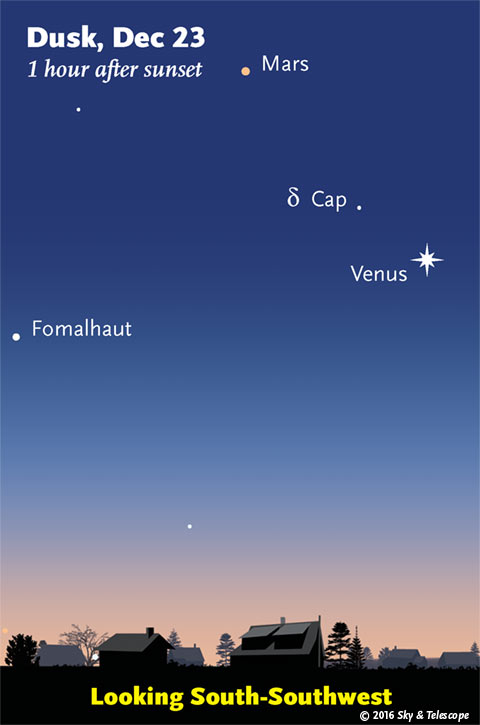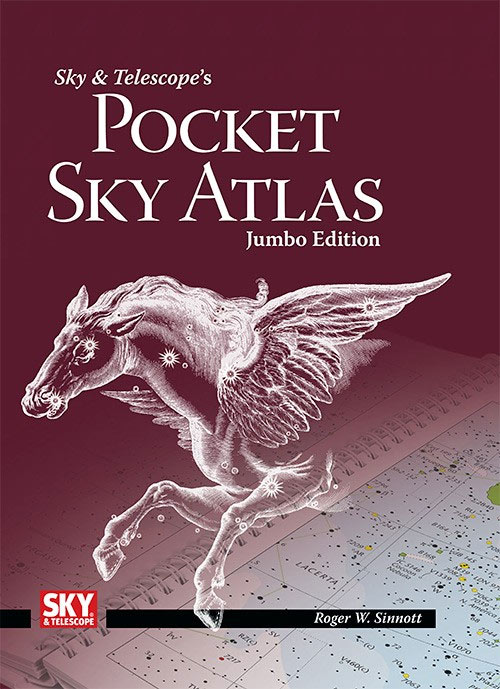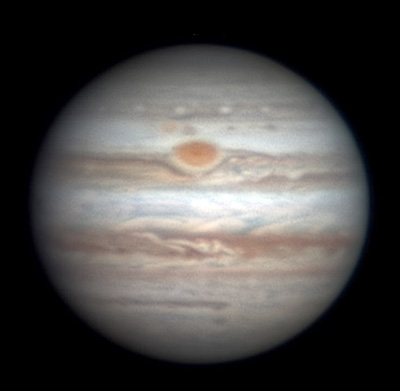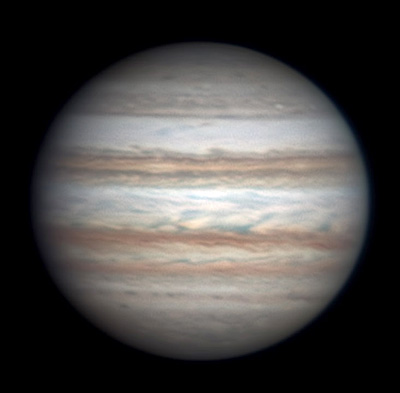Astronomy - This Week’s Sky at a Glance, December 16 – 24

The Venus-Mars-Fomalhaut triangle continues to shrink in the twilight. . .

. . .as Venus approaches Mars and the stars slide to the lower right behind the planets.
• Have you ever watched a Sirius-rise? If you can find a spot with a good view down to the east-southeast horizon, watch for Sirius to come up about two fists at arm's length below Orion's Belt. It rises now sometime around 8 p.m. depending on your location.
When a star is very low, it tends to twinkle quite slowly and often in vivid colors. Sirius is bright enough to show these effects well.
Saturday, December 17
• The Pleiades cluster shines high in the southeast after dinnertime, no bigger than your fingertip at arm's length. How many Pleiads can you count with your unaided eye? Take your time and keep looking. Most people count 6. With sharp eyesight, a good dark sky, and a steady gaze, you may be able to make out 8 or 9.
• The waning gibbous Moon is nicely up in the east after about 10 p.m. The Moon at this phase looks weird to a lot of people, because we're usually not out late enough to see it at night. Look about 7° to the Moon's lower left for Regulus in Leo, a very early harbinger of the coming spring.
Sunday, December 18
• Right after dark you'll find the Pleiades high in the east, with Aldebaran and the Hyades below them. Far below these, Orion is beginning to clear the horizon. By about 9 p.m. Orion is much higher and Sirius is sparkling below it, completing this famous tall stack of December stars.
Monday, December 19
• With the Moon out of the evening sky, and the cold December air often especially clean and clear, now's a fine time to get out the telescope and try your best on the Triangulum Galaxy, M33. It's passing very high overhead these evenings, big but dim. How much inside this ghostly galaxy can you detect and identify? A dark sky really matters! See Sue French's "M33 in a 10-inch Scope" with photo, drawing, and map in the December Sky & Telescope, page 54.
Tuesday, December 20
• Last-quarter Moon (exact at 8:56 p.m. EST). The Moon rises around midnight. Once it's well up you'll see that it's in Virgo under the tail of Leo. Jupiter rises below the Moon about an hour and a half later. By dawn Wednesday morning, they're high in the south.
• You are remembered, Carl Sagan (November 9, 1934 – December 20, 1996).
Wednesday, December 21
• Shortest day of the year. We reach the solstice at 5:44 a.m. EST (10:44 UT). This is when the Sun is at its southernmost declination in Earth's sky for the year and begins its six-month return northward. Winter begins in the Northern Hemisphere, summer in the Southern Hemisphere.
• Algol should be at its minimum brightness, magnitude 3.4 instead of its usual 2.1, for about two hours centered on 7:35 p.m. EST. Compare it to Gamma (γ) Andromedae, magnitude 2.1. Chart. Algol takes several more hours to fade and to rebrighten.

The waning Moon passes Jupiter and Spica high in the south these cold dawns. (The Moon is positioned for the time of dawn near the middle of North America.)
• Step out at the beginning of dawn Thursday morning the 22nd, and high in the south you'll find Jupiter, fainter Spica, and the waning crescent Moon in a line, as shown here. Bundle up and bring the telescope!
Thursday, December 22
• This is the time of year when Orion shines in the east-southeast after dinnertime. He's well up now, but his three-star Belt is still nearly vertical. The Belt points up toward Aldebaran and, even higher, the Pleiades. In the other direction, it points down to where bright Sirius is about to rise and twinkle furiously.
Friday, December 23
• Sirius and Procyon in the balance. Sirius, the Dog Star, sparkles low in the east-southeast after dinnertime. Procyon, the Little Dog Star, shines in the east about two fist-widths at arm's length to Sirius's left. If you live around latitude 30° (Tijuana, New Orleans, Jacksonville), the two canine stars will be at the same height above your horizon soon after they rise. If you're north of that latitude, Procyon will be higher. If you're south of there, Sirius will be the higher one.
Saturday, December 24
• This is the time of year when M31, the Andromeda Galaxy, passes your zenith soon after dark (if you live in the mid-northern latitudes. It goes precisely across your zenith if you live at latitude 41° north.) Binoculars show M31 just off the upraised knee of the Andromeda constellation's stick figure; see the big evening constellation chart in the center of Sky & Telescope.
_________________________
Want to become a better astronomer? Learn your way around the constellations! They're the key to locating everything fainter and deeper to hunt with binoculars or a telescope.
This is an outdoor nature hobby. For an easy-to-use constellation guide covering the whole evening sky, use the big monthly map in the center of each issue of Sky & Telescope, the essential guide to astronomy.

The Pocket Sky Atlas plots 30,796 stars to magnitude 7.6 — which may sound like a lot, but it's less than one per square degree on the sky. Also plotted are many hundreds of telescopic galaxies, star clusters, and nebulae. Shown above is the new Jumbo Edition for easier reading in the night. Click image for larger view.
Once you get a telescope, to put it to good use you'll need a detailed, large-scale sky atlas (set of charts). The basic standard is the Pocket Sky Atlas (in either the original or new Jumbo Edition), which shows stars to magnitude 7.6.
Next up is the larger and deeper Sky Atlas 2000.0, plotting stars to magnitude 8.5, nearly three times as many. The next up, once you know your way around, is the even larger Uranometria 2000.0 (stars to magnitude 9.75). And read how to use sky charts with a telescope.
You'll also want a good deep-sky guidebook, such as Sue French's Deep-Sky Wonders collection (which includes its own charts), Sky Atlas 2000.0 Companion by Strong and Sinnott, or the bigger Night Sky Observer's Guide by Kepple and Sanner.
Can a computerized telescope replace charts? Not for beginners, I don't think, and not on mounts and tripods that are less than top-quality mechanically (meaning heavy and expensive). And as Terence Dickinson and Alan Dyer say in their Backyard Astronomer's Guide, "A full appreciation of the universe cannot come without developing the skills to find things in the sky and understanding how the sky works. This knowledge comes only by spending time under the stars with star maps in hand."
This Week's Planet Roundup

On December 11th, NASA's Juno spacecraft made its third close swing over Jupiter's North Polar Region. Astro-imager Damian Peach assembled this color composite from raw images returned by Juno. Full-resolution view.

Seen equator-on from Earth: Jupiter's Great Red Spot side. . .

. . .and non-Red-Spot side, imaged by Christopher Go on November 30th and 27th, respectively. South is up. With Jupiter in good telescopic view pre-dawn, it's showing a huge white zone south of the brownish South Equatorial Belt, but nothing like that in the northern hemisphere. A very small telescope should be able to show the difference.
Mercury is fading and disappearing from evening view. Early in the week, you can still try for it in twilight about 26° to the lower right of Venus.
Venus (magnitude –4.3, in Capricornus) is the bright white "Evening Star" blazing in the southwest during and after twilight. In a telescope, it's a brilliant gibbous disc (about 61% sunlit) 19 arcseconds in diameter.
Mars (magnitude +0.8, in Aquarius) still glows in the south-southwest at dusk, about 16° upper left of Venus. In a telescope it's a tiny orange blob only 6 arcseconds in diameter.
Jupiter (magnitude –1.8, in Virgo) rises around 1 or 2 a.m. and shines brightly high the south-southeast by early dawn. Spot Spica 5° below it. In a telescope, Jupiter is 34 arcseconds in diameter, relatively small as Jupiter goes.
Saturn is out of sight in the glare of sunrise.
Uranus (magnitude 5.8, in Pisces) and Neptune (magnitude 7.9, in Aquarius) are well up in the southern sky right after dark. Info and finder charts.
__________________________
All descriptions that relate to your horizon — including the words up, down, right, and left — are written for the world's mid-northern latitudes. Descriptions that also depend on longitude (mainly Moon positions) are for North America.
Eastern Standard Time (EST) is Universal Time (UT, UTC, or GMT) minus 5 hours.
__________________________
"This adventure is made possible by generations of searchers strictly adhering to a simple set of rules. Test ideas by experiments and observations. Build on those ideas that pass the test. Reject the ones that fail. Follow the evidence wherever it leads, and question everything. Accept these terms, and the cosmos is yours."
— Neil deGrasse Tyson
— Neil deGrasse Tyson
No comments:
Post a Comment